Jacques Fath was considered one of the three most influential voices during post war culture. He brought about a whole new world of fashion that had men and women both turning their heads to stare. Fath was born in France with a Flemish origin. His father convinced and encouraged him to be a bookkeeper and a broker. Fath had other plans in mind. His great-grandmother was a dressmaker. This helped spur Fath to want a different career path than his father had wanted for him. Even from his younger years, Fath knew he always wanted to design clothing. He was a very artistic child. He taught himself, studied designs, costumes, and read about fashion in books. His first job started in a two-room salon, which eventually moved studios twice into bigger buildings. He always seemed to hire young assistants. This way they had fresh ideas and he could relate to them because he started off as a young adult as well. They usually went on to make their own lines of clothing and fashion. Fath introduced the first figure-fitting clothing line, which was mostly sold in high-end stores such as Lord Et Taylor and Hudsons.
He teamed up with Joseph Halpert to make a women’s clothing line in 1948. Fath also served in the military earlier that year and was taken to prison. When he was releasted from jail, he opened a salon with his wife. Fath brought more scandalous outfits to America that made women feel glamorous and sexy. Low necklines, tiny waists, full skirts, and very scandalous dresses were all part of his work. He always emphasized breasts and behinds. Cleavage was prevalent and slim skirts were often worn. Asymmetrical lines, draping, pockets, tight dresses, tucks, and tiers were all were a part of his designs. Also, lots of bright colors such as green and blue were included. Lower priced lines of clothing for day-to-day usage were sold in department stores. Sex appeal was a big influence with his designs. He created fabulous wedding dresses and introduced perfume. He was a very personable person and that helped to win people over and enhance his success. Fath died at the age of 42 due to leukemia. A friend of Jacques Fath said he was, “A French Designer who is out to make every women look like a great beauty…[he] should be remembered with the highest acclaim of his generation.”




